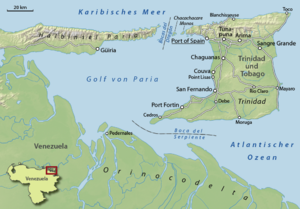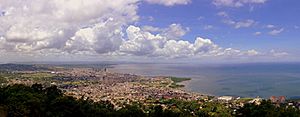Gulf of Paria facts for kids
The Gulf of Paria is a large, shallow body of water located between the island of Trinidad (part of Trinidad and Tobago) and the eastern coast of Venezuela. It covers about 7,800 square kilometers (3,000 sq mi) and is about 180 meters (590 feet) deep at its deepest point. The Gulf separates the two countries by as little as 15 kilometers (9 miles) at its narrowest and up to 120 kilometers (75 miles) at its widest. The water level (tides) changes about 1 meter (3 feet) twice a day.
The Gulf of Paria is known as one of the best natural harbors on the Atlantic coast of the Americas. Both Trinidad and Tobago and Venezuela share control of the Gulf. Trinidad and Tobago controls about 2,940 square kilometers (1,140 sq mi), which is about 37.7% of the Gulf. Venezuela controls the rest.
When Christopher Columbus first saw it, he named it the Gulf of the Whale (Golfo de la Ballena). However, by the 1800s, too much whaling caused whales to disappear from the area. They have not returned in large numbers. Later maps from the late 1700s sometimes called it the Sad Gulf (Golfo Triste).
In the north, the Gulf connects to the Caribbean Sea through a narrow passage called the Dragons' Mouths (Bocas del Dragón). This passage is between Venezuela's Paria Peninsula and Trinidad's Chaguaramas Peninsula. In the south, the Gulf connects to the Atlantic Ocean through the Columbus Channel. This channel is also known as the Serpent's Mouth (Boca de la Serpiente). It lies between Trinidad's Cedros Peninsula and the Orinoco Delta in Venezuela.
Oil and Natural Gas Discoveries
The Gulf of Paria is located in an area where Earth's plates meet and move. This movement has created a complex system of basins and folds. Over millions of years, special rocks from the Upper Cretaceous period helped create oil in Trinidad. These rocks were then covered by thick layers of sand and mud. The movement of the Caribbean plate created several smaller basins in Trinidad, each with its own oil and gas systems.
The Gulf of Paria is an important area for finding oil and natural gas. Natural gas has been found in the nearby Caroni basin on land. In the Gulf of Paria itself, both oil and gas have been discovered.
Sometimes, oil spills happen in the Gulf. For example, in 2021, an oil spill was found. Between 2018 and April 2021, there were almost 500 reported oil spills both on land and at sea in the area. These spills can harm the environment.
Important Fisheries
The Gulf of Paria has brackish water, which means it's a mix of fresh and saltwater. During the wet season, the water is less salty. There are many mangrove forests along the coasts of Venezuela and Trinidad in the Gulf. The Gulf is mostly shallow, with a smooth bottom made of fine mud, some shell pieces, and sand. These conditions make it a great place for fishing.
The nearby Orinoco Delta in Venezuela strongly influences the Gulf's waters. Large rivers like the Amazon and Orinoco bring a lot of fresh water and nutrients into the Gulf. These nutrients help many plants and animals grow, making the waters around Trinidad very productive. Because of this, Trinidad has more types of fish and other sea creatures than most other Eastern Caribbean islands. The Gulf of Paria is the most important fishing area in Trinidad for shrimp and many kinds of fish.
Fishermen in the area sometimes face safety challenges.
Major Ports and Shipping
The Gulf of Paria is home to several important ports and shipping facilities:
- The Port of Port of Spain
- Plipdeco's Port of Point Lisas in Couva
- Port of San Fernando
- Port of Point Fortin
- Pedernales in Venezuela's Delta Amacuro state
- Oldendorff Carriers floating facility: Since 2012, Oldendorff Carriers has used a floating facility with two cranes in Trinidadian waters. This facility helps transfer iron ore from Brazil to places in the Middle and Far East.
See also
- Piracy off the coast of Venezuela
 In Spanish: Golfo de Paria para niños
In Spanish: Golfo de Paria para niños




